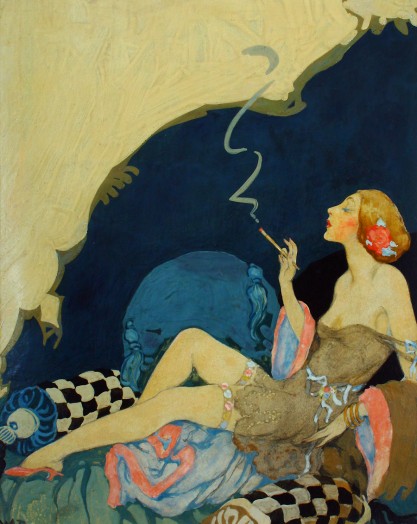


Dating to the mid-1920s, this lavishly colored and provocatively composed gouache painting by the highly regarded illustrator Willy Pogany is a rare surviving example of his commissioned silent film artwork. During the roaring ’20s, Pogany, known as one of the most prolific and inventive artists of the decade, worked with a number of film studios creating movie posters, set designs, and exhibitor’s book illustrations. In 1924, Douglas Fairbanks assigned Pogany the task of elevating silent film advertising posters to fine art, and the artist created a now-lost design for the star’s Thief of Bagdad. There is, as of yet, no complete list of films with which Pogany was associated, though it is known he helped create the Orientalist mood of Gilda Gray’s 1927 The Devil Dancer, and worked as an uncredited art director for the eerie horror classic The Mummy. In this view of a vamping and haughty flapper smoking in her lavishly decked out boudoir, Pogany’s talent for capturing the exotic and alluring is on display. We have not yet found the exact usage of this work, but our best guess is that it appeared in a United Artist or Fox Film Corporation exhibitor book. The central figure, in costume and attitude, is reminiscent of Gilda Gray herself. Painting is handsomely framed and silk matted behind glass in a hand carved basswood museum quality frame. Signed W.P. on the lower left corner.



William Andrew (“Willy“) Pogany –
(August 1882-1955) was a prolific Hungarian Illustrator especially revered for his work in Children’s books. His contemporaries include Coles Phillips, Edmund Dulac, Harvey Dunn, Walter Everett, Harry Rountree, Sarah Stilwell Weber, and N.C. Wyeth.
Pogany’s artistic style is heavily fairy-tale oriented and often feature motifs of mythical animals such as nymphs and pixies.
He used dreamy and warm pastel scenes with watercolor, oil painting, and specially pen and ink.
Painstakingly detailed and confident, Pogany’s artistry is remarkable.
In the 1920s & 1930s Pogany split his time between New York and Los Angeles, designing murals for the Ziegfeld Follies, working on set designs inspired by Joseph Urban, and executing commissioned portraits and mural designs for the elites in the arts, most notably William Randolph Hearst. These freelance jobs he completed in between his book illustration, magazine cover jobs, and working on the art deco advertising campaign for Djer-Kiss.


